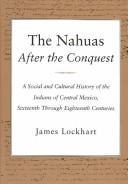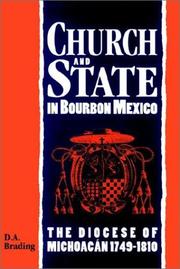| Listing 1 - 10 of 12 | << page >> |
Sort by
|
Book
ISBN: 9781108492546 9781108462921 1108492541 1108462928 9781108602310 1108600573 1108602312 1108585396 Year: 2019 Volume: 114 Publisher: Cambridge : Cambridge University Press,
Abstract | Keywords | Export | Availability | Bookmark
 Loading...
Loading...Choose an application
- Reference Manager
- EndNote
- RefWorks (Direct export to RefWorks)
In the sixty years following the Spanish conquest, indigenous communities in central Mexico suffered the equivalent of three Black Deaths, a demographic catastrophe that prompted them to rebuild under the aegis of Spanish missions. Where previous histories have framed this process as an epochal spiritual conversion, The Mexican Mission widens the lens to examine its political and economic history, revealing a worldly enterprise that both remade and colonized Mesoamerica. The mission exerted immense temporal power in struggles over indigenous jurisdictions, resources, and people. Competing communities adapted the mission to their own designs; most notably, they drafted labor to raise ostentatious monastery complexes in the midst of mass death. While the mission fostered indigenous recovery, it also grounded Spanish imperial authority in the legitimacy of local native rule. The Mexican mission became one of the most extensive in early modern history, with influences reverberating on Spanish frontiers from New Mexico to Mindanao.
History of Mexico --- anno 1500-1599 --- Mexico --- Meksiko --- Stany Zjednoczone Meksyku --- Meksyk --- Estados Unidos Mexicanos --- Meḳsiḳe --- Mexique (Country) --- Messico --- Méjico --- República Mexicana --- United States of Mexico --- United Mexican States --- Anáhuac --- メキシコ --- Mekishiko --- מקסיקו --- Maxico --- History --- Missions. --- Church history. --- Espagne --- --Colonie --- --Mexique --- --Découvertes --- --Missions --- --Histoire de l'Église catholique --- --Mexico--History--Spanish colony, 1540-1810 --- Mexico--History--Spanish colony, 1540-1810 --- Missions --- Church history --- Colonie --- Découvertes --- Histoire de l'Église catholique --- Mexique --- Mexico--History--Spanish colony, 1540-1810 - Missions --- Mexico--History--Spanish colony, 1540-1810 - Church history

ISBN: 0804719276 Year: 1992 Publisher: Stanford Stanford University Press
Abstract | Keywords | Export | Availability | Bookmark
 Loading...
Loading...Choose an application
- Reference Manager
- EndNote
- RefWorks (Direct export to RefWorks)
Nahuas --- Nahua (Indiens) --- History --- Social life and customs --- Histoire --- Moeurs et coutumes --- Mexico --- Mexique --- Spanish colony, 1540-1810 --- Nahuas - History. --- Nahuas - Social life and customs. --- Mexico - History - Spanish colony, 1540-1810.
Book
ISSN: 00659746 ISBN: 9781606180259 1606180258 Year: 2012 Volume: 102/5 Publisher: Philadelphia : American Philosophical Society,
Abstract | Keywords | Export | Availability | Bookmark
 Loading...
Loading...Choose an application
- Reference Manager
- EndNote
- RefWorks (Direct export to RefWorks)
"Examines 'the historical underpinnings of the sea change in the pictorial representation of calendrical time that took place in Hispanic Mesoamerica.' Discusses the deeply entrenched circular view of time in the West and the indigenous temporal representations in square or quadrangular form. The post-contact representation of time is thus an example of how fundamental native concepts were affected by the clash of cultures we call the Spanish conquest"--Provided by publisher.
Calendrier maya. --- Perception du temps --- Calendar - Mexico --- Maya calendar --- Mexico - History - Conquest, 1519-1540 --- Mexico - History - Spanish colony, 1540-1810. --- Central America - History - To 1821 --- Calendar --- Mexico --- Central America
Book
ISBN: 0521080738 9780521080736 Year: 1972 Volume: 14 Publisher: Cambridge Cambridge University press
Abstract | Keywords | Export | Availability | Bookmark
 Loading...
Loading...Choose an application
- Reference Manager
- EndNote
- RefWorks (Direct export to RefWorks)
Mexico --- Historical geography --- History --- -Mexico --- Meksiko --- Stany Zjednoczone Meksyku --- Meksyk --- Estados Unidos Mexicanos --- Meḳsiḳe --- Mexique (Country) --- Messico --- Méjico --- República Mexicana --- United States of Mexico --- United Mexican States --- Anáhuac --- メキシコ --- Mekishiko --- מקסיקו --- Historical geography. --- Maxico --- Mexico - Historical geography --- Mexico - History - Spanish colony, 1540-1810
Book
ISBN: 0521078741 9780521078740 9780521102070 Year: 1971 Volume: 10 Publisher: London Cambridge university press
Abstract | Keywords | Export | Availability | Bookmark
 Loading...
Loading...Choose an application
- Reference Manager
- EndNote
- RefWorks (Direct export to RefWorks)
Mexico --- Economic conditions --- Social conditions --- History --- Economic conditions. --- Social conditions. --- -Mexico --- Meksiko --- Stany Zjednoczone Meksyku --- Meksyk --- Estados Unidos Mexicanos --- Meḳsiḳe --- Mexique (Country) --- Messico --- Méjico --- República Mexicana --- United States of Mexico --- United Mexican States --- Anáhuac --- メキシコ --- Mekishiko --- מקסיקו --- Mexico - Economic conditions --- Mexico - Social conditions --- Mexico - History - Spanish colony, 1540-1810 --- History of Mexico --- anno 1700-1799 --- anno 1800-1899

ISBN: 0521220513 0521527058 0511665261 0511865651 9780521220514 9780511665264 9780521527057 Year: 1979 Volume: 31 Publisher: Cambridge : Cambridge University Press,
Abstract | Keywords | Export | Availability | Bookmark
 Loading...
Loading...Choose an application
- Reference Manager
- EndNote
- RefWorks (Direct export to RefWorks)
The kings of Spain forbade foreigners and other 'undesirables' to immigrate to Spanish America. They saw aliens as threatening imperial, religious and mercantile security, and it might therefore be assumed that the Spaniards were xenophobic and intolerant. Dr Nunn's study shows that statutes tell only part of the story. In the years 1700-60 some 3 per cent of the foreign-born in Mexico were non-Spaniards who had entered the colony illegally. Who were these people, where did they come from, and what were their motives? In answering these questions, Dr Nunn demonstrates how illegal immigrants often escaped official detection and how even those known to the authorities were usually allowed to remain and make new lives for themselves. Neither Protestant nor Jew went to the stake in eighteenth-century Mexico. Harassment was more likely to come from officials seeking funds for an impecunious government than from the Inquisition.
Migration. Refugees --- History of Mexico --- anno 1700-1799 --- Immigrants --- Mexico --- Emigration and immigration --- History --- -Emigrants --- Foreign-born population --- Foreign population --- Foreigners --- Migrants --- Persons --- Aliens --- Emigration and immigration. --- -Immigrants --- -Mexico --- Meksiko --- Stany Zjednoczone Meksyku --- Meksyk --- Estados Unidos Mexicanos --- Meḳsiḳe --- Mexique (Country) --- Messico --- Méjico --- República Mexicana --- United States of Mexico --- United Mexican States --- Anáhuac --- メキシコ --- Mekishiko --- מקסיקו --- -Migration. Refugees --- Emigrants --- Arts and Humanities --- Immigrants - Mexico --- Mexico - Emigration and immigration --- Mexico - History - Spanish colony, 1540-1810

ISBN: 0521460921 052152301X 0511885156 0511586434 Year: 1994 Publisher: Cambridge : Cambridge University Press,
Abstract | Keywords | Export | Availability | Bookmark
 Loading...
Loading...Choose an application
- Reference Manager
- EndNote
- RefWorks (Direct export to RefWorks)
In the eighteenth century the Mexican Church experienced spiritual renewal and intellectual reform. The establishment of Franciscan missionary colleges, of the Oratory, and of convents and sisterhoods was to the great benefit of the diocese of Michoacán. Thriving confraternities demonstrated the vigour of parochial life. But the secular clergy remained divided between a wealthy elite and an impecunious mass of curates and country vicars, with the cathedral chapter dominated by a group of enlightened peninsular canons. Charles III and his successor expelled the Jesuits, secularised mendicant parishes, investigated closely popular religion, stripped the clergy of their immunity from royal courts and then seized their wealth. In 1810 priests from the Michoacán diocese led the popular Insurgency which challenged Spanish rule. Here therefore is a rounded portrait of the Mexican Church at its meridian, touching upon virtually all aspects of religious life. At its core is the clash between post-Tridentine baroque Catholicism and enlightened despotism.
Catholic Church. Diocese of Michoacan de Ocampo (Mexico) --- -Church history --- -Mexico --- Mexico --- Michoacan de Ocampo (Mexico) --- -History --- -Catholic Church. Diocese of Michoacan de Ocampo (Mexico) --- -Catholic Church. --- Michoacán de Ocampo (Mexico : Diocese : Catholic Church) --- Catholic Church. --- Church history --- Michoacán de Ocampo (Mexico) --- Michoacán, Mexico --- Michoacán (Mexico : State) --- Michuacán (Mexico) --- Mechuacan (Mexico) --- Gobierno del Estado de Michoacán de Ocampo (Mexico) --- History --- Spanish colony, 1540-1810 --- 18th century --- Michoacan de Ocampo (Mexico: State) --- Catholic Church. - Diocese of Michoacâan de Ocampo (Mexico) - Church history - 18th century. --- Michoacâan de Ocampo (Mexico) - Church history - 18th century. --- Mexico - Church history - 18th century. --- Mexico - History - Spanish colony, 1540-1810. --- Arts and Humanities

ISBN: 0198218605 9780198218609 Year: 1975 Publisher: London Oxford university
Abstract | Keywords | Export | Availability | Bookmark
 Loading...
Loading...Choose an application
- Reference Manager
- EndNote
- RefWorks (Direct export to RefWorks)
Social classes --- History --- Mexico --- Mexique --- Ethnic relations --- 17th century --- Politics and government --- Social conditions --- Relations interethniques --- Histoire --- Politique et gouvernement --- Conditions sociales --- -Class distinction --- Classes, Social --- Rank --- Caste --- Estates (Social orders) --- Social status --- Class consciousness --- Classism --- Social stratification --- -Social conditions --- -Social classes --- -Mexico --- Meksiko --- Stany Zjednoczone Meksyku --- Meksyk --- Estados Unidos Mexicanos --- Meḳsiḳe --- Mexique (Country) --- Messico --- Méjico --- República Mexicana --- United States of Mexico --- United Mexican States --- Anáhuac --- メキシコ --- Mekishiko --- מקסיקו --- 17th century. --- Social classes - Mexico --- Mexico - History - Spanish colony, 1540-1810 --- Mexico - Social conditions - To 1810
Book
ISBN: 9781107199408 1107199409 9781108185639 9781316648841 1316648842 1108187862 1108185630 1108196276 Year: 2018 Publisher: Cambridge : Cambridge University Press,
Abstract | Keywords | Export | Availability | Bookmark
 Loading...
Loading...Choose an application
- Reference Manager
- EndNote
- RefWorks (Direct export to RefWorks)
In the first history of laywomen and the church in colonial Mexico, Jessica L. Delgado shows how laywomen participated in and shaped religious culture in significant ways by engaging creatively with gendered theology about women, sin, and guilt in their interactions with church sacraments, institutions, and authorities. Taking a thematic approach, using stories of individuals, institutions, and ideas, Delgado illuminates the diverse experiences of urban and rural women of Indigenous, Spanish, and African descent. By centering the choices these women made in their devotional lives and in their relationships to the aspects of the church they regularly encountered, this study expands and challenges our understandings of the church's role in colonial society, the role of religion in gendered and racialized power, and the role of ordinary women in the making of colonial religious culture.
Catholic women --- Women, Catholic --- Christian women --- History --- Catholic Church --- Church of Rome --- Roman Catholic Church --- Katholische Kirche --- Katolyt︠s︡ʹka t︠s︡erkva --- Römisch-Katholische Kirche --- Römische Kirche --- Ecclesia Catholica --- Eglise catholique --- Eglise catholique-romaine --- Katolicheskai︠a︡ t︠s︡erkovʹ --- Chiesa cattolica --- Iglesia Católica --- Kościół Katolicki --- Katolicki Kościół --- Kościół Rzymskokatolicki --- Nihon Katorikku Kyōkai --- Katholikē Ekklēsia --- Gereja Katolik --- Kenesiyah ha-Ḳatolit --- Kanisa Katoliki --- כנסיה הקתולית --- כנסייה הקתולית --- 가톨릭교 --- 천주교 --- Catholic women - Mexico - History - Spanish colony, 1540-1810
Book
ISBN: 9781477312445 9781477312605 1477312447 1477312609 1477312617 1477312625 Year: 2017 Publisher: Austin, [Texas] : University of Texas Press,
Abstract | Keywords | Export | Availability | Bookmark
 Loading...
Loading...Choose an application
- Reference Manager
- EndNote
- RefWorks (Direct export to RefWorks)
Many scholars believe that the modern concentration camp was born during the Cuban war for independence when Spanish authorities ordered civilians living in rural areas to report to the nearest city with a garrison of Spanish troops. But the practice of spatial concentration—gathering people and things in specific ways, at specific places, and for specific purposes—has a history in Latin America that reaches back to the conquest. In this paradigm-setting book, Daniel Nemser argues that concentration projects, often tied to urbanization, laid an enduring, material groundwork, or infrastructure, for the emergence and consolidation of new forms of racial identity and theories of race. Infrastructures of Race traces the use of concentration as a technique for colonial governance by examining four case studies from Mexico under Spanish rule: centralized towns, disciplinary institutions, segregated neighborhoods, and general collections. Nemser shows how the colonial state used concentration in its attempts to build a new spatial and social order, and he explains why the technique flourished in the colonies. Although the designs for concentration were sometimes contested and short-lived, Nemser demonstrates that they provided a material foundation for ongoing processes of racialization. This finding, which challenges conventional histories of race and mestizaje (racial mixing), promises to deepen our understanding of the way race emerges from spatial politics and techniques of population management.
Sociology of minorities --- anno 1500-1799 --- anno 1800-1899 --- Mexico --- Racism - Mexico - History --- Race discrimination - Mexico - History --- Biopolitics - Mexico - History --- Social structure - Mexico --- Urbanization - Mexico --- Mexico - History - Spanish colony, 1540-1810 --- Mexico - Race relations - History --- Mexico - Politics and government - 1540-1810 --- Racism --- Race discrimination --- Social structure --- Biopolitics --- Organization, Social --- Social organization --- Anthropology --- Sociology --- Social institutions --- Bias, Racial --- Discrimination, Racial --- Race bias --- Racial bias --- Racial discrimination --- Discrimination --- Race prejudice --- Prejudices --- Anti-racism --- Critical race theory --- Race relations --- Political behavior --- Human behavior --- Political science --- Sociobiology --- History. --- Urbanization --- History --- Social aspects --- Politics and government
| Listing 1 - 10 of 12 | << page >> |
Sort by
|

 Search
Search Feedback
Feedback About
About Help
Help News
News